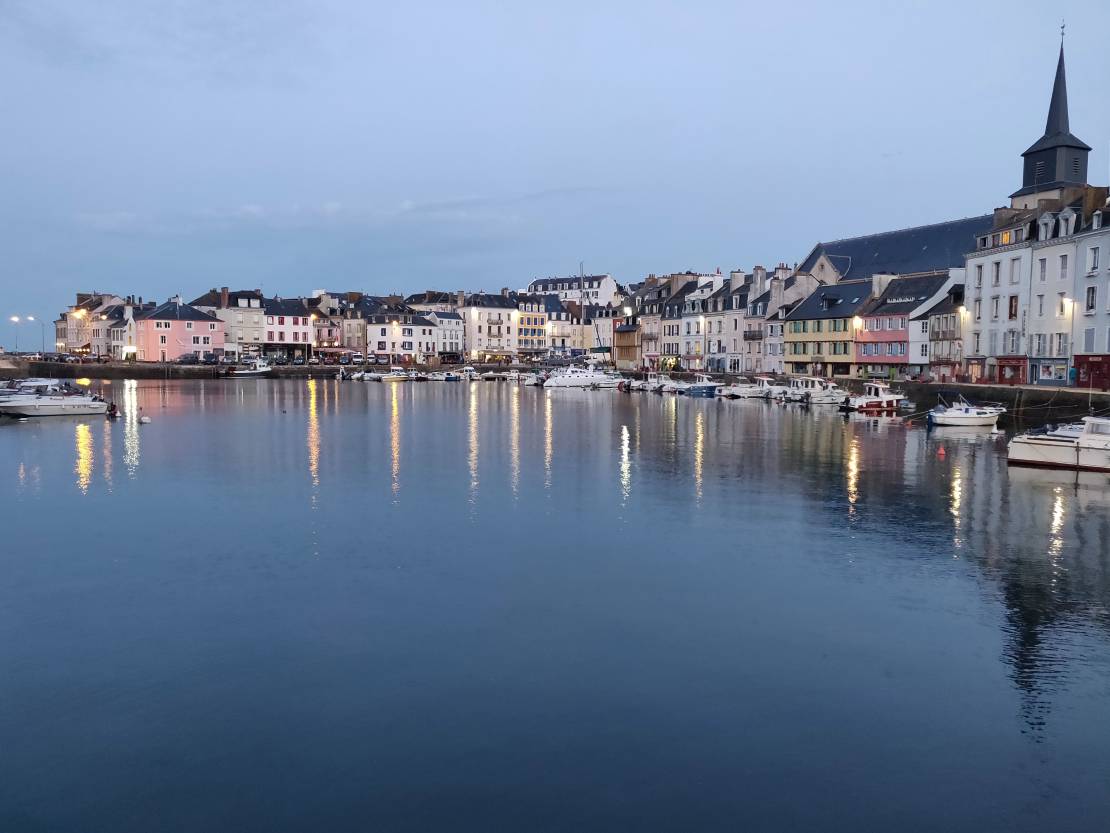
Resource studies on electric boats
I started thinking about how solar electric boats work and are designed and how to potentially build one, after seeing the performance of the …
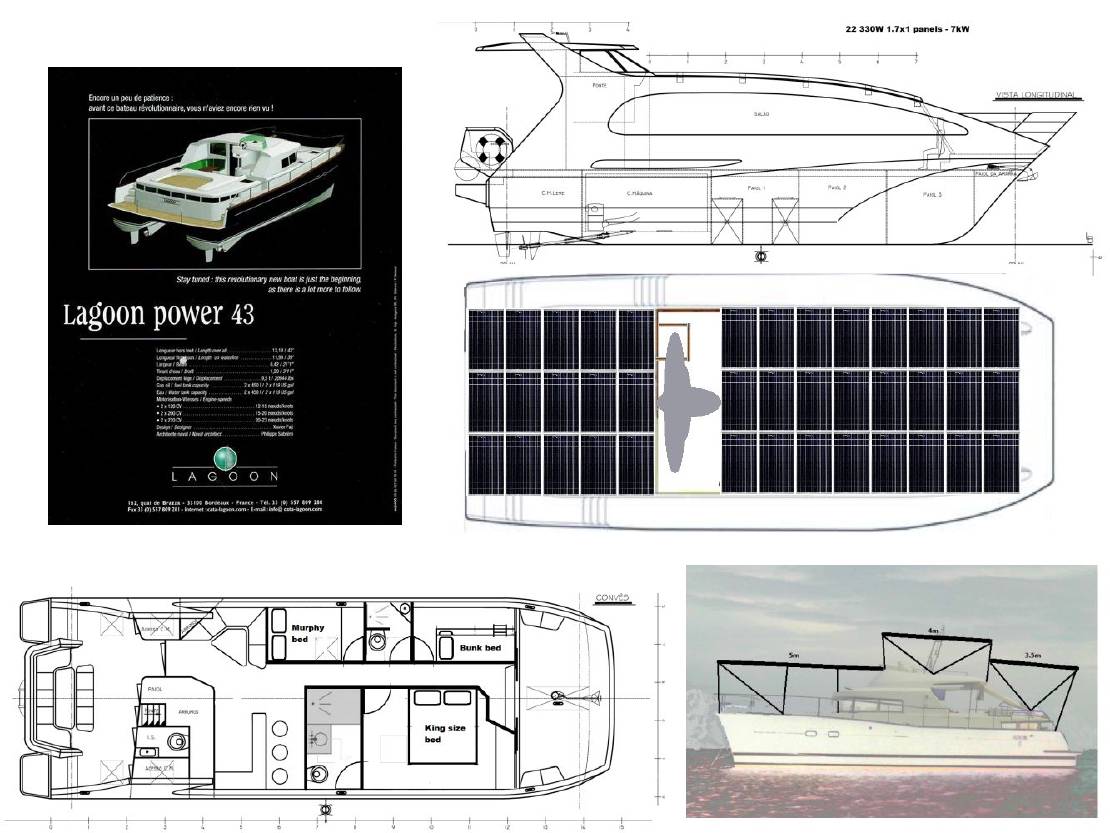
Here is a summary of my research, readings and thoughts on the type of boat that could serve as a starting point for our project.
I have spent time on sites like YachtWorld or iNautia for a while now, to daydream about boats for sale and to explore their specifications. However, for several months now, when I have checked these sites, it is with an eye on boats that would both suit our desire to live aboard (size, model, etc.) and also would be convertible to electric propulsion and solar energy.
The multihull, especially the catamaran, is the ideal boat to harvest the sun’s energy. A catamaran of a given length has twice the width of a monohull of the same length. This provides twice the surface area to install the solar panels. Being wider and on two hulls, it is much more stable and allows to mount a superstructure to support the solar panels without too much impact on the stability of the boat.
Ideally, I am interested in a spacious catamaran, which will be comfortable to live in and will offer space to install technical equipment. Our project will be to adapt it to spend part of the year there, autonomous in energy for both propulsion and the normal household needs. We are looking for a comfortable living space and I have set the minimum length at 12 meters (39 feet). 14 or 15 meters seem “very comfortable”. Longer vessels than that would be complex to maneuver with only the two of us. I therefore limit my search to catamarans of 12 to 17 meters.
A few additional criteria must be taken into account. Should we find a sailing catamaran with the idea of removing the mast to enable the construction of a solar panel roof, or rather a motor catamaran? I think both options are valid, but I prefer the power catamaran scenario because having a mast and sails complicates the modification work. In addition to that, power catamarans generally have an interior and an exterior helm station, which would be a big plus. They do not have a trampoline at the front but a solid bow platform, better able to support the superstructure for the solar panels.
Another criterion is the material of the hull of the boat, but it turns out that by searching only for power catamarans, they are almost always built with fiberglass, unless they are home built catamarans (some in wood), or commercial catamarans (metal). Fiberglass suits me, because it is easier to repair and maintain than aluminum or wood. The problems of galvanic corrosion on aluminum hulls would add complexity to the installation of electric propulsion. Carbon fiber would be another suitable material, but is very expensive and seems to be reserved for racing boats for the moment.
Here are my search shortcuts, visited very regularly:
The budget is of course a very important selection variable, but it is also very subjective. In our case, planning on the upcoming sale of our house and the purchase of a more modest apartment, we can afford buying a catamaran for a little over 200k Euros if it is in working order. The work to switch to electric propulsion and install the solar panel cover can be done after we start sailing the boat. If we can find a catamaran that has end-of-life diesel engines, or a damaged boat, in this case, with a much lower price, we can launch the electrification project right away.
Aquila: all the power catamaran models are recent and expensive. The oldest models available second-hand are from 2014 and cost more than 500k. The 44 model has the owner’s cabin at the front, which offers comfy space, but… it is out of our budget. Note of interest: an Aquila 44 has been converted to electric propulsion with a 5.6 kWp (kilowatts peak) solar roof, more details on the Torqeedo blog.
Bali: their power catamrans are also too new and too expensive. Their 4.3 MY model is brand new, so no second-hand market.
Flashcat: a Spanish shipyard; they built the 435, 43 and 43S models and we can find some of them second-hand within our budget, for hulls from 2008-2010. I don’t know this shipyard, but they seem to have built beautiful catamarans.
Fountaine Pajot: some Cumberland 44s from 2004-2006 and Summerland 40s from 2010 might be suitable. The Summerland is a bit too small though. There are several other interesting models in their product line, such as the Cumberland 46, the Queensland 55 and the MY40 released last year, but the used market for them is out of our budget.
Lagoon: the 43 Powercat seems to fit our requirements very well. It comes in a charter version and an owner version. The latter has an aft cabin that runs the full width of the catamaran. I haven’t visited one yet, but in photos, videos and on the interior plans, it looks very comfortable and almost luxurious for a 13-meter boat.
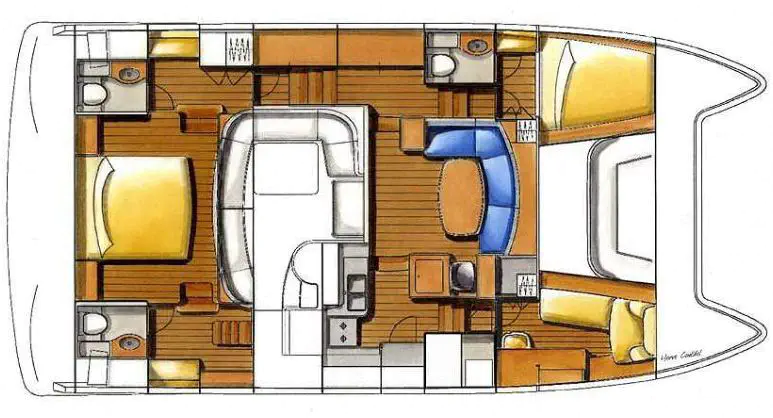
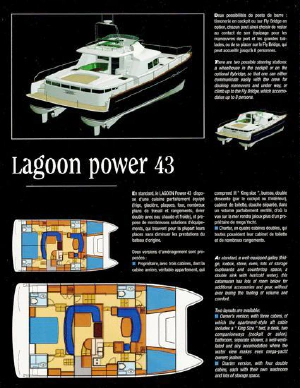
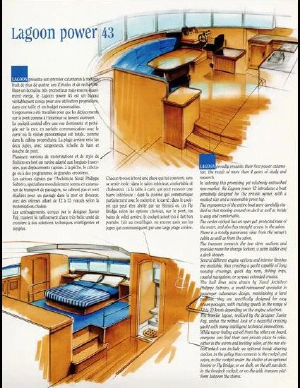

The design of superstructure for the solar panels would not be easy, but there is space over the bow deck at the same height as the fly deck for 3.5 meters, then above the fly deck for 4 meters and of course above the stern deck for 5 meters. With this configuration and on a width of only 5 meters to be conservative, we could expect to install at least 10 kWp of solar panels on the Lagoon 43 Powercat.

Leopard: only second-hand 39 Powercat models are within our budget. The 43, 47 and 51 are currently way too expensive.
There are a few other brands I didn’t know about, like Prowler and their 45, 48 and 50 foot power catamarans from 2002 to 2006, some of which are within our budget.
In addition to the catamarans from production line shipyards, some catamarans have been custom built on client order, or only in a very limited series.
Dean Catamarans: before filing for bankruptcy, they launched their Jag 530 and 550 motor catamarans. We currently find a damaged Jag 530 in Spain, where everything needs to be redone.
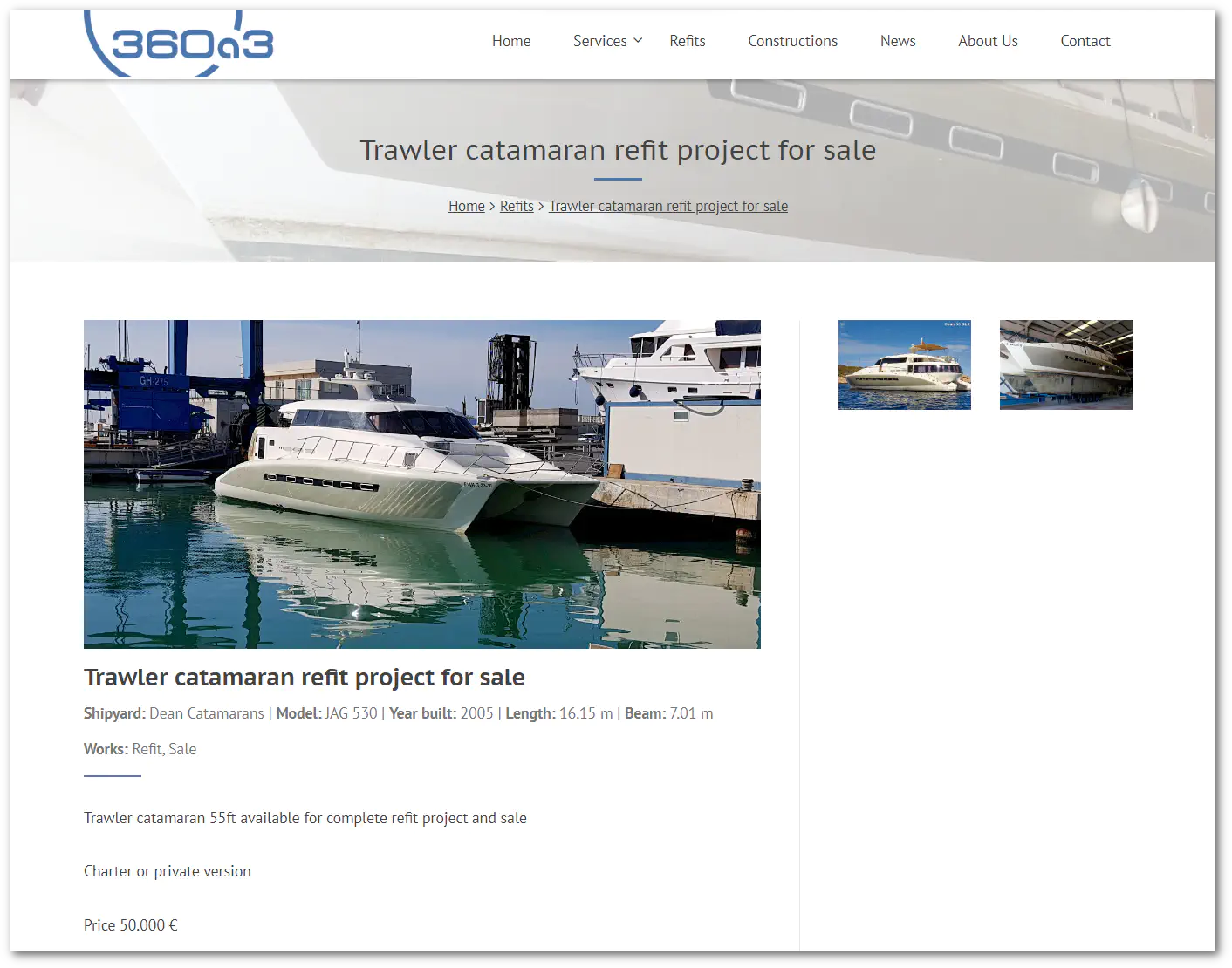
With its 16 meters long and 7 meters wide, it offers enormous possibilities in solar energy generation, at least 14 kWp.

Nautiber: a shipyard that builds commercial boats in Portugal, they built passenger catamarans for tour operators. Two are currently available, including the Nautiber 15.
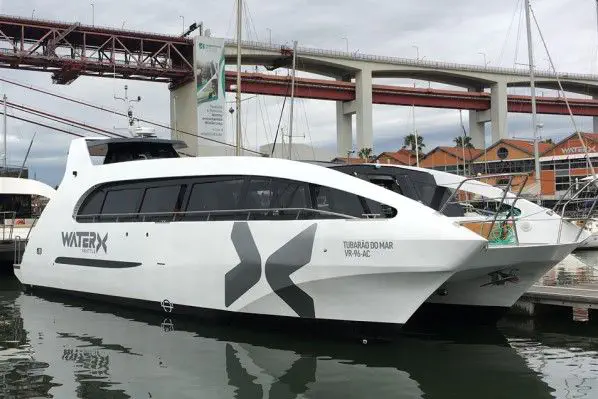
This passenger boat can be re-arranged into a comfortable habitable catamaran by redesignin the interior layout and it has have a suitable surface area for the 7 kWp solar panels.

I also spotted a most likely custom built catamaran, which was then converted to electric propulsion. It is a hybrid vessel though, because it uses a gasoline generator to produce electricity. I exchanged several messages with the seller last month to get the hull drawings. It is attractively priced, less than 100k, but it is a little small for our project at 12 meters and there is a lot of work to be done on it. In addition, its electric propulsion with 2 Lynch electric motors seems too limited to push its 8.5 tons at seas.
After finding some examples of catamaran wrecks that could be repaired and modified for our project, I wanted to further explore in this direction. The repair work is complex to estimate and it adds risk to the project, but the purchase price is often very attractive, almost always below 100k for catamarans sometimes 55 or even 60 feet long. For example, I found an interesting damaged boats in Vietnam and quite a few in the Caribbean, the Bahamas or Florida due to the frequent hurricanes in this region. I had found a Lagoon 43 that had water flooding its hulls, so the engines, the electricity and the interior had to be redone. It was offered at $79k in Florida. However, we quickly decided that we could not manage such a project on the other side of the world, so we refocused our research on boats in Europe.
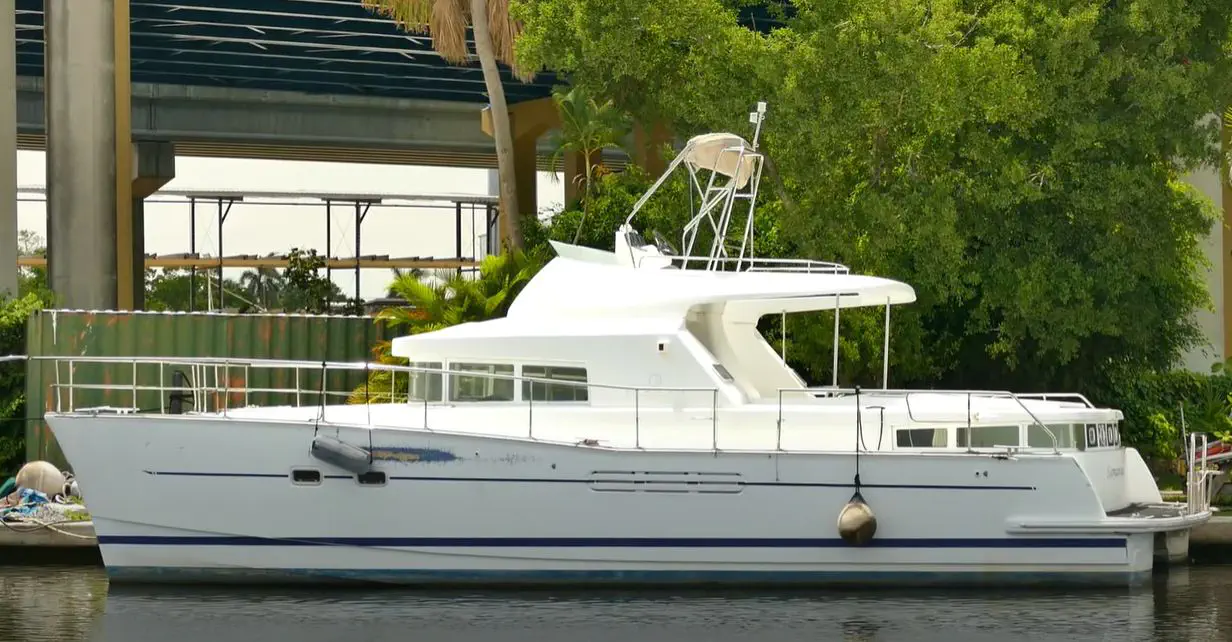
It is interesting to compare these used and damaged catamarans with the offer of new catamarans with electric motors and solar energy generation. We know of course the Silent Yachts, but they are absolutely not in our budget, as their entry-level model costs more than 2 million. There are however some other shipyards with competing products, which are less expensive and less luxurious.
Azura Marine builds the Aquanima 40. They recently sailed around the island of Bali with their prototype using only solar energy. Series production has not yet started, but this shipyard is aiming for a price of around 500k. They are also designing a larger model, the Aquanima 45, which should be offered from 650k.
Another shipyard with a 12 meter long electric and solar catamaran is Sunconcept. Its model Cat 12 is offered for 420k.
On one hand, it is reassuring that some shipyards manage to build and sell electric catamarans for less than half a million. This confirms that the project is feasible with a lower budget by investing time to work ourselves on the project. On the other hand, I can’t help but think that it would be simpler and faster to buy an Aquanima 40 or a Cat 12 and enjoy exploring the Mediterranean instead of designing and managing such a conversion project. Decisions, decisions…

I started thinking about how solar electric boats work and are designed and how to potentially build one, after seeing the performance of the …
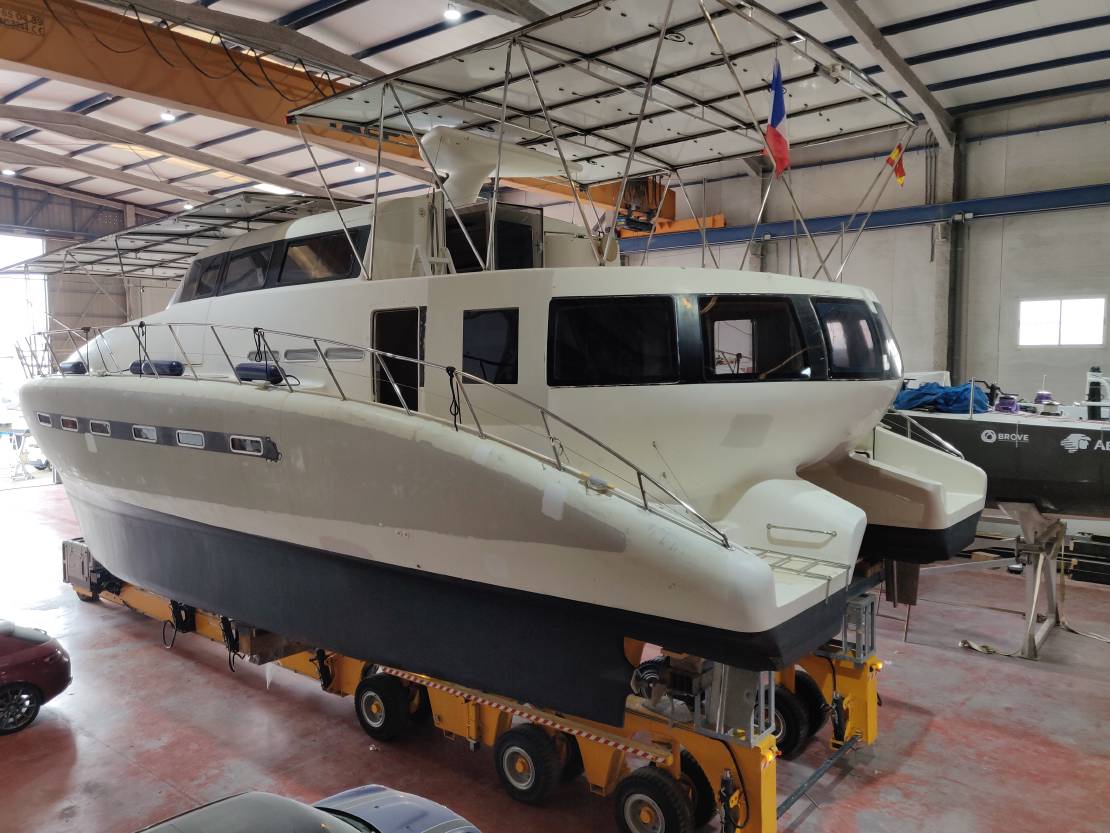
The last two months have been full of activity and progress! Having Escargot on the water for nearly six weeks was an invaluable experience, …